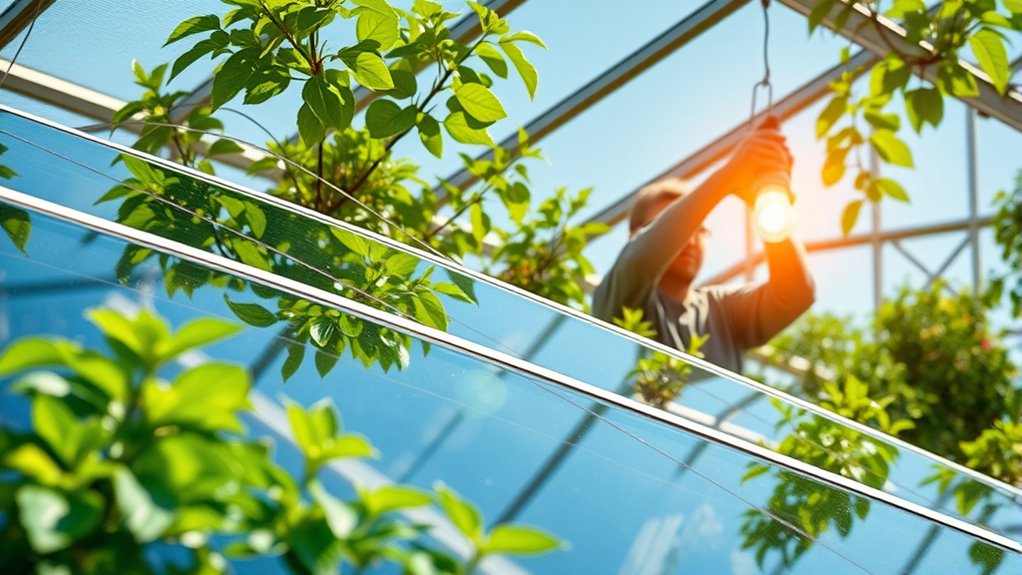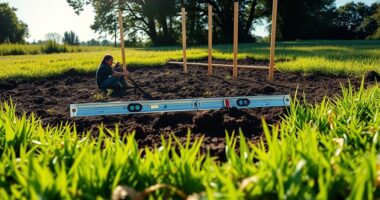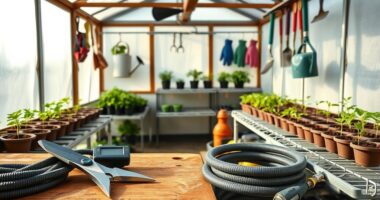Adding electricity to your greenhouse can considerably improve your growing capabilities. Start by evaluating your electrical needs based on size and layout. You’ll need essential components like a grounding system and properly sized service. Follow safety guidelines to prevent hazards, like using Ground Fault Circuit Interrupters and ensuring compliance with local codes. Regular maintenance is vital for longevity and efficiency. If you want to learn more about the installation process and other important details, keep going.
Key Takeaways
- Assess your greenhouse’s size and electrical load requirements, including lighting, cooling, and irrigation systems, to determine power needs.
- Plan the installation by positioning electrical panels to maximize sunlight and airflow while allowing for future expansion.
- Use insulated wiring in conduit and install a grounding system to protect against moisture and electrical faults.
- Ensure compliance with local codes, utilizing GFCIs in damp areas, and avoid circuit overloads to enhance safety.
- Schedule regular maintenance inspections and keep detailed records to ensure the electrical system remains functional and up-to-date.
Assessing Your Electrical Needs
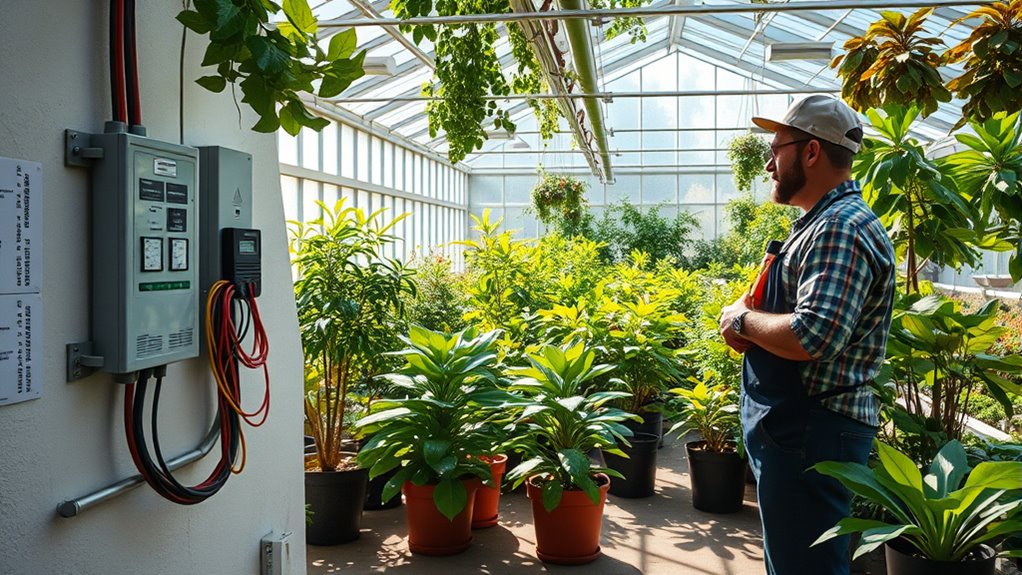
How do you determine the electrical needs for your greenhouse? Start by evaluating the size and layout of your space. Larger greenhouses demand more power, so factor that into your calculations.
Position electrical panels thoughtfully to avoid obstructing sunlight and airflow. Plan for future expansion; you’ll want enough capacity for additional circuits down the line.
Review your electrical load demands by considering key components like horticultural lighting, cooling systems, and irrigation pumps. Each of these draws significant power, so distribute loads efficiently across zones.
Don’t forget about environmental factors like humidity, which can impact your system’s design. A well-planned approach guarantees your greenhouse operates smoothly and is ready for any growth you might envision. Additionally, understanding the importance of proper ventilation ensures that your electrical systems will function optimally in varying conditions.
Essential Electrical Components
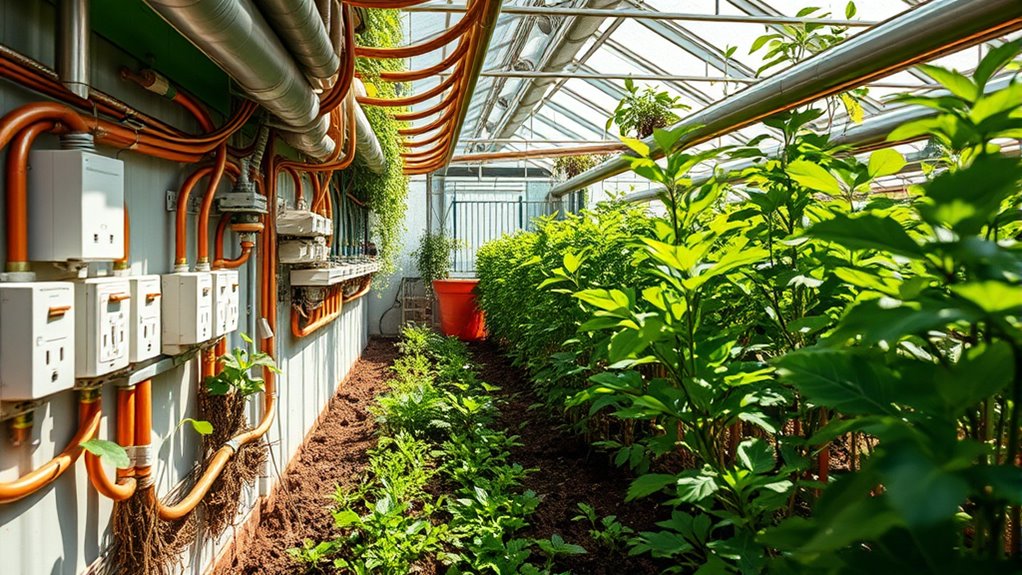
When setting up your greenhouse, understanding the essential electrical components is key to ensuring a safe and efficient operation.
Start with a grounding system to protect against high voltage from faults or lightning. You’ll need an appropriately sized electrical service to handle your load and provide a safe entrance for supply wires.
A grounding system is essential for protecting against high voltage and ensuring safe electrical service in your greenhouse.
Distribution panels will help distribute electricity through branch circuits to your equipment.
Don’t forget about insulated wiring placed in conduit to guard against moisture and dust.
Circuit breakers are vital for protecting each circuit from overloads and faults.
Installation Steps for a Safe Setup
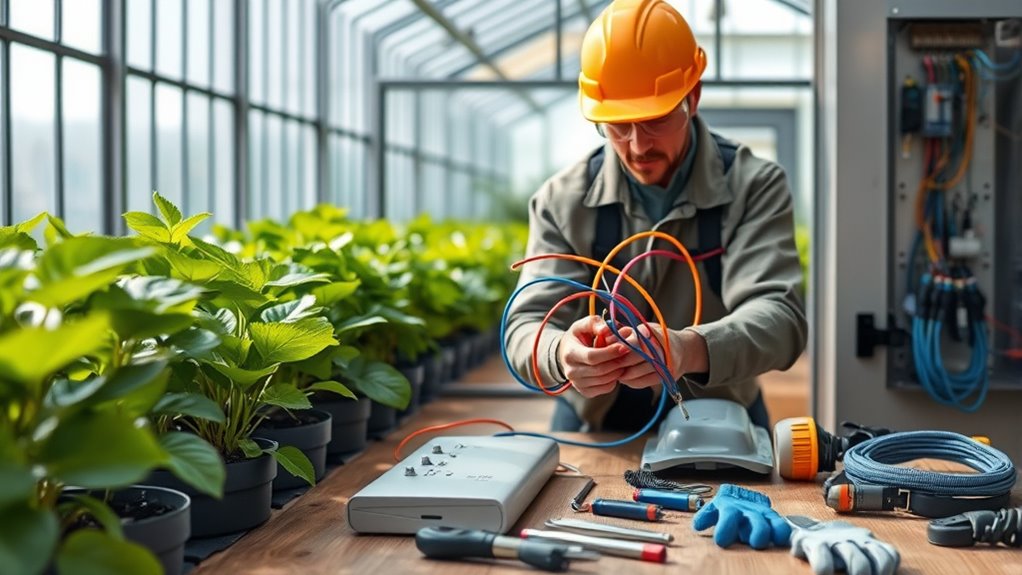
After laying the groundwork with the right electrical components, you can now focus on the installation steps that guarantee a safe setup for your greenhouse’s electrical system.
Start by evaluating your power needs and selecting the appropriate wire type. Dig a trench at least 18 inches deep for the conduit, ensuring it’s made of durable PVC.
Install a subpanel in the greenhouse, connecting a feeder circuit from the main panel. Don’t forget to include a disconnect switch for easy power control.
Pull wires through the conduit, grounding all equipment to prevent shock. Install GFCI-protected outlets for your systems, along with circuit breakers for overload protection.
Finally, conduct thorough inspections and tests to verify everything functions correctly.
Safety Considerations for Electrical Work
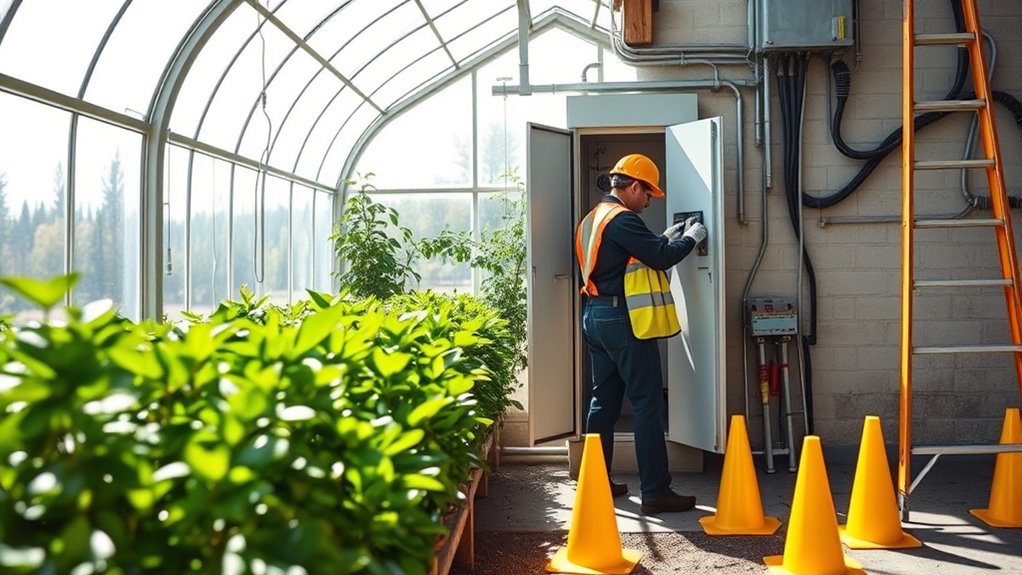
While working with electricity in a greenhouse, it’s crucial to prioritize safety to prevent accidents and injuries.
Start by confirming all installations comply with local and national electrical codes. Use Ground Fault Circuit Interrupters (GFCIs) in damp areas to minimize shock risks. Be cautious about overloading circuits, as this can lead to overheating and fires.
Regularly inspect electrical components for physical damage, and always use waterproof enclosures to protect against moisture. Keep fire extinguishers handy and make sure staff knows how to use them.
Develop emergency plans and conduct drills to prepare for any electrical mishaps. By following these safety considerations, you’ll create a safer environment for both yourself and your greenhouse operations.
Ongoing Maintenance and Future Upgrades
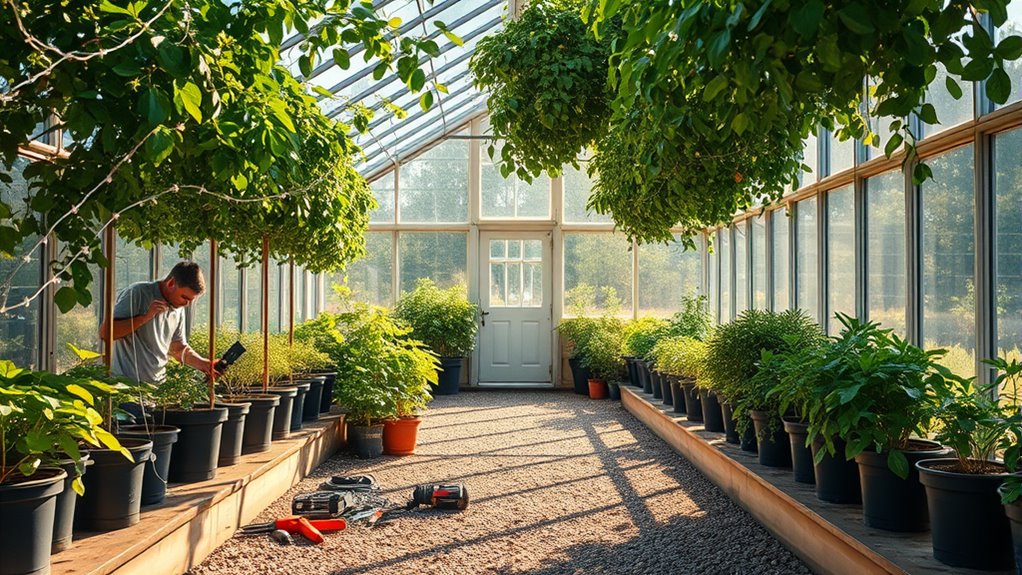
To keep your greenhouse’s electrical system running smoothly, ongoing maintenance and future upgrades are essential. Regular inspections by licensed electricians help guarantee compliance with codes and catch potential issues before they escalate.
Check for worn-out components like wiring and circuit breakers during maintenance to prevent failures. Schedule maintenance during off-peak hours to minimize disruptions.
For future upgrades, consider increasing electrical services to handle new equipment loads and incorporating energy-efficient technologies that lower costs. Plan for scalability to avoid costly rework and invest in automation to enhance operational efficiency. Additionally, ensure you are aware of cookie management options to maintain transparency regarding data collection during upgrades.
Don’t forget about emergency preparedness; standby generators and automatic transfer panels can keep your systems running during outages. Keeping detailed records of maintenance will also help you track your electrical system’s condition over time.
Frequently Asked Questions
What Permits Are Required for Greenhouse Electrical Installations?
When planning electrical installations for your greenhouse, you’ll need to contemplate several permits.
Generally, electrical work requires permits, regardless of size. You might also need zoning permits to adhere to local laws about placement and size.
If you’re constructing a permanent structure, a building permit is essential for safety.
Always check with your local authorities, as requirements can vary considerably based on your location and specific project details.
How Do I Choose the Right Electrician for My Project?
Choosing the right electrician’s like picking the perfect tool from a well-stocked shed.
You’ll want someone with experience in projects similar to yours, so check their background. Make sure they’re licensed, insured, and bonded, ensuring safety’s at the forefront.
Look for glowing reviews and solid recommendations. Finally, compare proposals carefully, focusing on scope, timeline, and cost.
A good electrician won’t only meet your needs but also spark your project to life!
Can I Install Electrical Systems Myself?
You can install electrical systems yourself, but it’s important to take into account safety first.
Make sure you understand local codes and regulations, as they vary. If you’re unsure about any aspect, it’s wise to consult a professional or even hire an electrician for complex tasks.
Always prioritize safety by using GFCI outlets and proper materials.
What Are the Costs Associated With Greenhouse Electricity?
Imagine your greenhouse as a vibrant ecosystem, thriving in the sunlight.
Yet, beneath it all, electricity can be a hidden drain on your resources. You’ll find that costs can soar over $1,000 monthly, especially with lighting systems consuming a significant chunk.
Seasonal changes and regional rates further add complexity. By understanding these factors, you can navigate the currents of electricity costs, ensuring your greenhouse remains a flourishing sanctuary without breaking the bank.
How Can I Improve Energy Efficiency in My Greenhouse?
To improve energy efficiency in your greenhouse, start by insulating walls and using double-glazed windows to minimize heat loss.
Upgrade to LED lighting for significant energy savings and guarantee your lamps are clean for maximum output.
Implement high-efficiency ventilation fans, and seal them when not in use.
Consider adding thermal screens to retain heat in winter while reflecting excess heat in summer.
Finally, explore renewable energy options like solar power for sustainable energy management.
Conclusion
By adding electricity to your greenhouse, you’re not just enhancing your gardening experience; you’re also boosting your plants’ productivity. Did you know that greenhouses with proper electrical setups can increase yields by up to 30%? With the right electrical components and safety measures, you can create an environment that fosters growth year-round. So, take the plunge—invest in electricity for your greenhouse and watch your plants thrive like never before!
